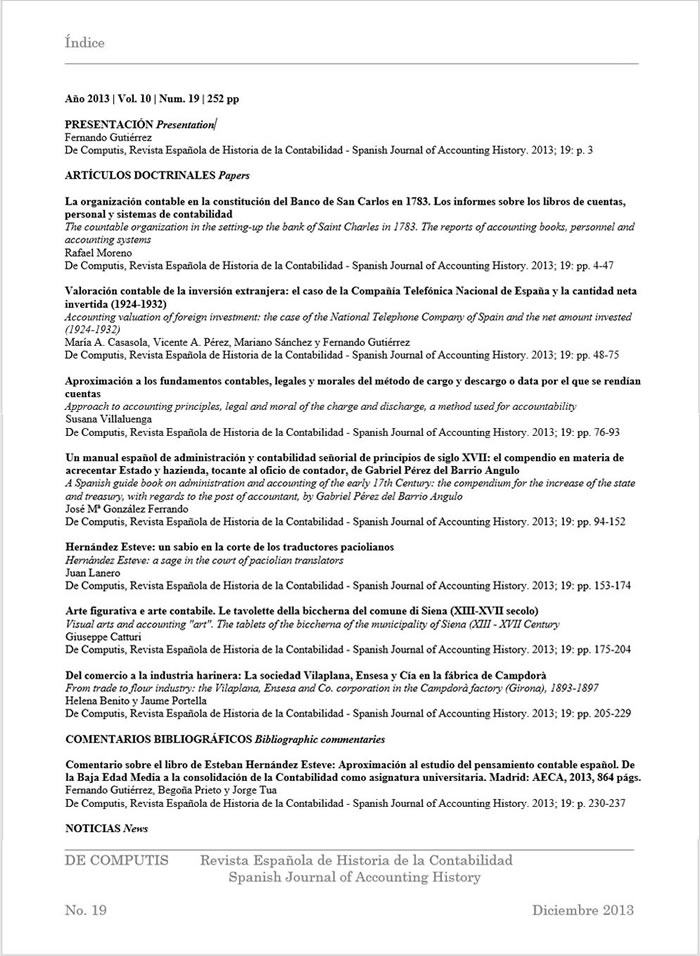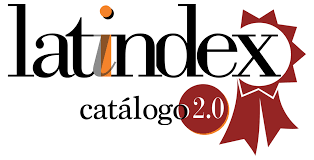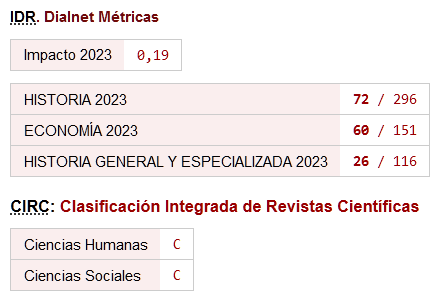Visual Arts And Accounting "Art". The Tablets Of The Biccherna Of The Municipality Of Siena (XIII - XVII Century)
DOI:
https://doi.org/10.26784/issn.1886-1881.v10i19.270Keywords:
Accountability, Visual arts, Siena, XII –XVII CenturyAbstract
Among the fine arts including the so-called "beautiful" arts, in other words the forms of activity that, according to Vasari, aiming at representing the concept of beauty, an aesthetic value such as architecture, dance, poetry, painting , sculpture and music. In this article we focus on painting, in particular on one of its expression and manifestation, unique and original.
The pictorial compositions that represent events and situations of real life environments or configurations are all sources of inestimable value. These sources represent wide and large historical archives and knowledge for interested observers.
On the other hand art is also the set of techniques, tools and methods used by artists for carrying out a practical work in the field of human activity, so you can write of art referring to a craft or a profession. Thus we have the medical art, art forensics, etc.. but also the accounting art. This last is exercised by those who show themselves able to store and systematize, according to a predetermined and rigorous method, the administrative events, translated in quantitative terms; this translation was carried out by any firm in order to gather crucial information useful for the good governance of the firm.
The cognitive aim of the accounting art remains constant over time, but the tools and the use of them, related to the art, change overtime and gradually increase the baggage of knowledge concerning the efficient use of accounting records for managerial purposes.
In our study we refer to accounting art practiced in the Middle Ages by merchants' families, bankers, municipalities, hospitals, charities and religious congregations. In particular, we focus on the office of the Biccherna of the municipality of Siena which was responsible for the management of public financial resources.
The office of the Biccherna was composed of a "president" - the treasurer (called Camarlingo) - and four Superintendents (called Provveditori) in charge for six months.
The accounting books on which the Camarlingo recorded the various daily financial transactions were composed of loose sheets and, therefore, they were initially held together by a larger sheet on which was written the period of reference and the name of the Camarlingo. Subsequently, to hold together the accounting loose sheets, a hard cover began to be used. In particular, the hard cover was made of wood, whose consistency and rigidity could facilitate the consultation and the use of the accounting loosed sheets.
The two wooden tablets, one placed on the top and one on the bottom, were tied with leather straps, whilst a closing buckle was placed on the front side, thus forming a sort of "real book".
At least in Siena from 1257, the use of painting on wooden tablets spread over in order to make up the anonymity and repetitiveness of those accounting books.
Many and very famous Sienese painters were called for painting the tablets of the Biccherna: Duccio, Lorenzetti, Giovanni di Paolo, Sano di Pietro, Domenico Beccafumi and many others. The artists mostly painted the main room of the Biccherna the one in which financial transactions, and sometimes administrative duties, were taking place: the Camarlingo , the Provveditori and some citizens were portrayed while paying taxes. On the work table, tools for the financial accounting art were often painted: books, pens, ink, scrapers, scissors, coins, bags etc.. Looking at the numerous pictorial representations of the tablets, collected mostly in the State Archives of Siena (others are exhibited in the most famous museums around the world), we can see some significant aspects of the cultural evolution of the medieval community of Siena. These representations allow us to draw immediate information of changes not only in pictorial art adopted by the authors of the paintings, but also in the organization of the Financial Office of the City (the Biccherna), and the increasing importance that it was attributed to the essential tools for practicing the accounting art. We can acquire information concerning the evolution of the "method" adopted in recording financial data about the activity of the Biccherna only by reading the papers included in the various "books", but this purpose is complementary to the focus of this research.
In short, watching in chronological order the Biccherna tablets, we can "read the time", or better the life lived in Siena by its community and in particular its most important financial public office, the Biccherna.
The study aims to highlight the correlation between visual arts and accounting art through the analysis of the painted tablets covering the accounting books of the Biccherna of Siena.
Downloads
Downloads
Published
How to Cite
Issue
Section
License

This work is licensed under a Creative Commons Attribution-NonCommercial-ShareAlike 4.0 International License.










